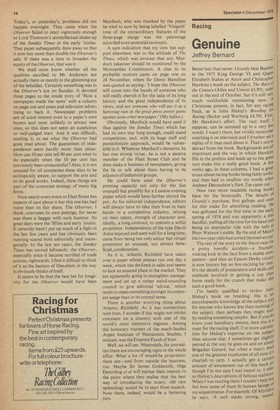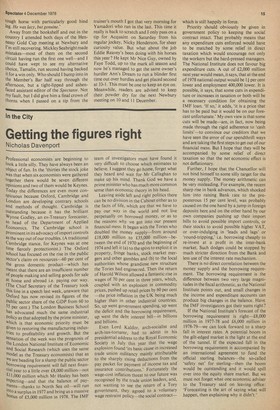Racing
Genuine
Jeffrey Bernard
Better late than never. Grundy beat Bustino in the 1975 King George VI and Queen Elizabeth Stakes at Ascot and Christopher. Hawkins's book on the subject, The Race 01 the Century (Allen and Unwin £3.95), came
out at the end of October, but it's still verY much worthwhile mentioning now. A Christmas present, in fact, for any racing freak, as is John Hislop's Breeding for Racing (Seeker and Warburg £4.50). First, Mr Hawkins's effort. The race itself, I suppose, can be summed up in a very few words. I wasn't there, but vividly remember watching it on television and I'd rather see a replay of it than read about it. That's not to detract from the book. Backgrounds are all important and the way in which Hawkins fills in the prelims and leads up to the great race make this a really good book. A fe'N weeks ago, in these columns, I had a great moan about racing books being fairly awful, and then had to swallow my words when Andrew Devonshire's Park Top came out.
Now two more readable racing books have hit the bookstalls. The details of Grundy's purchase, first gallops and even his diet make for absorbing reading. He was galloped for the first time in the earlY spring of 1974 and was apparently a real handful, pulling all the time for his head and being an unpopular ride with the lads at Peter Walwyn's stable. By the end of March the two-year-olds had sorted themselves out.
The rest of the story to the Ascot race via a pretty horrific accident—a fracture' making kick in the face from a stable corn' panion--and then an Epsom Derby victorY is now history but no less exciting for that. It's the details of preparation and skills and methods involved in getting a top class horse ready for the crunch that make this such a good book. I'm barely qualified to review John Hislop's book on breeding. His is an encyclopaedic knowledge of the subject and, for anyone who knows less than nothing° the subject, then perhaps they might start by reading something simpler. But if you do know your hereditary onions, then this is a must for the racing shelf. I've more admira• tion for Hislop's expertise on the subject than anyone else. I sometimes get slightlY peeved at the way he goes on and on about Brigadier Gerard, but when a man's bre.rl one of the greatest racehorses of all time ft, s churlish to carp. I actually got a certain amount of amusement oui of this book al' though I'm not sure I was meant to. I refer to Hislop's descriptions of famous stallions. When I was reading them I couldn't help but,. feel how some of them fit human beings 01 my acquaintance. For example. Of Alycidon he says, 'A well made, strong, sound' tough horse with particularly good hind leg. He was lazy, but genuine.'
Away from the bookshelf and out in the country I attended both days of the Hennessy Gold Cup meeting at Newbury and "Ti still recovering. Mickley Seabright made mistakes—most of them on the second circuit having run the first one well—and I could have wept to see my alternative Choice, Tamalin, run second having backed it for a win only. Who should I bump into in the Member's Bar half way through the afternoon, but a tight-lipped and ashenfaced assistant editor of the Spectator. Not my fault, but I did give him a final crown of thorns when I passed on a tip from the trainer's mouth I got that very morning for Yamadori who ran in the last. This time it really is back to scratch and I only pass on a tip for Acquaint on Saturday from his regular jockey, Nicky Henderson, for sheer curiosity value. But what about the job Eddie Reavey's been doing with his horses this year ? He kept Mr Nice Guy, owned by Faye Todd, up to the mark all season and now he's managed to get the same owner's hurdler Ann's Dream to run a blinder first time out over hurdles and get placed second at 33-1. This must be one to keep an eye on. Meanwhile, readers are advised to keep their powder dry for the next Newbury meeting on 10 and 11 December.







































 Previous page
Previous page